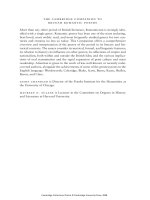The cambridge companion to british roman 53
Bạn đang xem bản rút gọn của tài liệu. Xem và tải ngay bản đầy đủ của tài liệu tại đây (39.09 KB, 1 trang )
The living pantheon of poets in 1820
against a larger body of alternative poetry. Whether we wish to argue that
Keats eschews politics, ideology, and the everyday in his poetry, or whether
we want, with Jerome McGann, to argue that these are deeply reactionary
poems,35 we need to see that his verse acquires some of its power from arising
within a contemporary struggle over the power of poetry, both its aesthetic
power and its power to change minds. No matter which canon we embrace,
it should be understood as an interested act of replacing the encyclopedic
pantheon of the living poets with the sacred book of the anthology which
seeks to keep alive poets by interring them far from the affiliations and
conflicts that gave their poetry life.
NOTES
1 On the issue of anthologizing Romanticism, see, e.g., the special issue of Romanticism on the Net 7 (August 1997).
2 Stuart Curran, “Romantic Poetry: Why and Wherefore?,” in The Cambridge
Companion to British Romanticism, ed. Stuart Curran (Cambridge: Cambridge
University Press, 1993), p. 217.
3 Shelley, “England in 1819,” in Shelley’s Poetry and Prose, ed. Donald H. Reiman
and Neil Fraistat, 2nd edn., (New York: W. W. Norton, 2002), pp. 1, 2–3. Subsequent references in the text.
4 Samuel Taylor Coleridge, Biographia Literaria, ed. James Engell and W. Jackson
Bate (Princeton: Princeton University Press, 1983), vol. i, p. 38.
5 Among other good work on print culture and Romanticism, see Kevin Gilmartin,
Print Politics: The Press and Radical Opposition in Early Nineteenth-Century
England (Cambridge: Cambridge University Press, 1996), and Paul Magnuson, Reading Public Romanticism (Princeton: Princeton University Press,
1998).
6 See J. R. de Jackson, Annals of English Verse: A Preliminary Survey 1770–1835
(New York: Garland, 1985), and Romantic Poetry by Women: A Bibliography
1770–1835 (Oxford: Oxford University Press, 1993).
7 On the importance of drama and theatre to the period, see, among other good
work, Julie Carlson, In the Theatre of Romanticism: Coleridge, Nationalism, and
Women (Cambridge: Cambridge University Press, 1994); Jeffrey N. Cox, In the
Shadows of Romance: Romantic Tragic Drama in Germany, England, and France
(Athens, OH: Ohio University Press, 1987); and Jane Moody, Illegitimate Theatre
in London, 1779–1840 (Cambridge: Cambridge University Press, 2000).
8 On Satire’s importance to Romanticism, see Gary Dyer, British Satire and the
Politics of Style, 1789–1832 (Cambridge: Cambridge University Press, 1997),
and Steven Jones, Satire and Romanticism (New York: St. Martin’s Press, 2000).
9 William St. Clair, The Reading Nation in the Romantic Period (Cambridge: Cambridge University Press, 2004). See also Jon Klancher, The Making of English
Reading Audiences, 1790–1832 (Madison: University of Wisconsin Press, 1987).
10 See, e.g., James Chandler, England in 1819: The Politics of Literary Culture and
the Case of Romantic Historicism (Chicago: Chicago University Press, 1998),
pp. 303–49.
31
Cambridge Collections Online © Cambridge University Press, 2008









